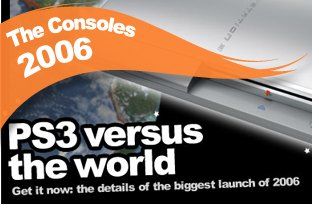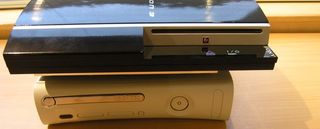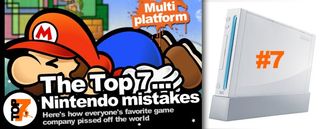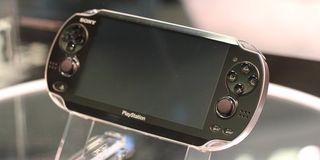How gaming has changed in the last five years
Hey guys, remember 2006? Neither do we! But we seem to have written about a bunch of stuff about it...
The games industrymoves at the pace of an Olympic sprinter, but it doesn’t alwaysgo forward. It’s more like a drunken Olympic sprinter. Sometimes it goes forward,sometimes diagonalish, or backwards, or into a public fountain because oh my god wouldn’t it feel sooo good to go swimming right now?
As March marks GamesRadar’s 5th anniversary, we’ve beendigging up bits of GR's pastall month, and now we’re recapping the past five years of the entire industry – the consoles, games, and oursilly coverage of it, from 2006 to 2011. Considering how much has changed, we can’t begin to imagine what 2016 will look like...

2006 ushered in the final two players in the modern console generation, completing the sacred hardware triptych which still towers over the altar of console gamery.
The PS3 launch
Early in the year, we said goodbye to the PS1, and devoured PlayStation 3 screens and videos like someone might in an alternate dimension in which screens and videos are edible and taste really good. At the peak of the pre-E3 PS3 hype, we explained the console, and a few days later, told you what it does (we hadn't installed our anti-redundancy module yet).
It was to be the most powerful home console ever. Big, big deal! The best way to explain our wave of excitement is to create a poem out of our March 2006 PS3 news story headlines. OK, that may not be the best way, but it's amusing:
PS3 still in hiding,
PS3 finally unveiled,
PS3: November!
Built-in PS3 hard drive confirmed!
Ratchet on PS3!
PS3 to debut for $500?

Above: Sony sent us a wooden PS3 replica before launch, so we made it grapple with a 360
Sign up to the GamesRadar+ Newsletter
Weekly digests, tales from the communities you love, and more
There were two primary PS3 opinion camps: those who believed it was destined to repeat the PS2's success, and those who believed that the price would sink it, at least initially. When we plugged one in for the first time, we loved it - why wouldn't we? Even so, you already know which camp predicted more accurately. Hint: it wasn't the one which included market researcher Yankee Group...
"PlayStation 3 will reach 30 million sales in five years in North America, comfortably beating Microsoft Xbox 360 and Nintendo Wii, according to American analysts who predict Sony to emerge once again as the leading console creator by 2011," reads an August 2006 news story about the analyst.

Above: Chris Slate, former editor-in-chief of PSM, former GR editor Christian Nutt, and current GR senior editor Mikel Reparaz prepare to rip open a couple of shiny new PS3s
"It's predicted that 360 will reach 27 million and that Nintendo can expect to shift only 11 million Wiis. This means that even if Microsoft doubles the success of Xbox - which sold 15 million in the US by July 06 - it wouldn't be quite enough to topple Sony's lead." Tee-hee.
The Wii launch
Meanwhile, we were covering the lead-up to the Wii with similar gusto, telling idiots what it does and six reasons they need it. Actually, saying that "we covered" it isn't really accurate - former Nintendo editor, now executive editor Brett Elston did almost all of the covering. And at first, he covered it with love.

Above: loooooooooooooooooooool
"Revolution will be better than the PlayStation 3 and the Xbox 360. Put together. It'll be more compelling, more interesting, more exciting and have better games. Crazy talk? The inane twitterings of a shattered mind? Unfocused fanboy enthuseo-blab? Not a bit of it. Revolution will be bestest. And you'd be a donkey to think otherwise," wrote Brett in an article introduction I just ensured he has to suffer through reading again.
He was absolutely right, though, just... only if the majority of GR's readers are in the 75-and-up demographic. It wasn't long before all of our anticipation gave way to cynicism.
"... there's more to this magic box than its eyebrow-raising wand," wrote Brett in his lyrically-titled feature, 'Beyond the Wand.'
As the Wii was still being called the 'Revolution' at the time, "eyebrow-raising wand" probably wasn't intended as a euphemism. Anyway, the article isn't negative at first glance, but give it a quick skim and you'll find that it only compliments the system for being simple, and also, small, while detailing everything it lacks. Come 2007, and "creating the Wii" is the seventh entry in Brett's list of the top seven Nintendo mistakes.

"Five years from now, when the PS4 and NextBox show up, they're going to jump in hardware power again. And then Nintendo's left with a machine that looks two generations old instead of one. The motion controls, now considered somewhere in between 'the best damn thing that's ever happened in the world' to 'gimmicky stupid childish nonsense,' will be super played out and exploited," wrote Brett.
If you're itching to know what happened, don't worry - you lived it! It's 2011 now! How lucky you are.

The motion sensation
Jump forward to the present day, and the Wii’s declining sales suggest that the innovation and clever marketing that first elevated it to the top of the charts has lost some of its pull. The increase in HDTV saturation has made its 480p – a term few consumers probably knew until recently – seem archaic. We complained about its relative lack of power in 2006, but its limitations are far more apparent today, when iPhone games look as good as or better than Wii games. Nevertheless, it's got some great games,remains the best-selling console of this generation, and is far from its death throes.
Meanwhile, Sony and Microsoft whipped their R&D and marketing departments into a motion control frenzy. Fad or not, The Wiggles-inspired gameplay is a valuable commodity at moment, and both companies were in need of lifetime-extending elixirs to buy them more time before the next console cycle.
Microsoft attempted to out-innovate Nintendo, opting for the entirely-controllerless Kinect, but built a marketing campaign nearly identical to Nintendo’s 2006 multi-generational lifestyle campaign, and has left green living rooms around the world in its wake.

Above: Gross as it was, we do have the Kinect marketing campaign to thank for some fantastic Photoshop opportunities
Sony, however, built the Wiimote-like Move controller, but directed its marketing at appreciators of snark with its fictional VP, Kevin Butler. The glowing balls haven’t seen the same success as Kinect, but the PlayStation has a few more tricks up its sleeve. Sony has also been heavily backing 3D TVs, which, again, we’d never heard of in 2006, and bolstering PlayStation Network’s offerings. Oh, and it just announced the PSP’s successor, the NGP, which will go head-to-head with Nintendo’s 3DS.
Connect, not Kinect
If you ask me, however, this generation's most notable improvement hasn't been motion control, better graphics, or bigger, more complex games - it's the internet. I know the internet wasn't invented in 2006, that one guy who was about to scoff in the comments, but what we were doing with it then looks pathetically archaic compared to what we're doing with it now. With Xbox Live and PlayStation Network, we've streamed HD Netflix movies to our TVs, seen a a fantastic rise in indie titles, and downloadable games in general, and could havelearned to play the saxaphone or somethinghad we used the time we spent playing CoD 4 multiplayer to practice. And on the mobile front, the NGP will sport 3G support, and Wi-Fi is everywhere (it's going through your brain right now!).

Tools which empower users to access everything they want on the internet at any time - that's the new Big Thing. If you'd told us in 2006 that both id Software and Epic Games would be developing iPhone games by 2010, we'd have said, "What's an iPhone?" Then, after you explained, we'd have said, "Bullshit!" But bullshit it isn't. We almost have tricorders, and they play games.
On the next page, the games...
Most Popular



